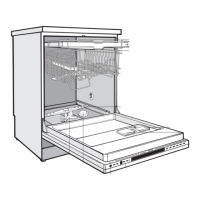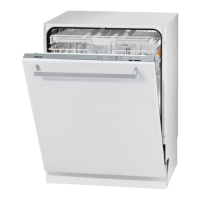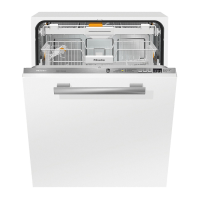Do you have a question about the Miele G 879 SCVI and is the answer not in the manual?
Describes the physical parts of the dishwasher, including baskets, spray arms, and filters.
Explains the function of buttons, touch pads, and indicator lamps on the control interface.
Details the salt reservoir, rinse aid dispenser, and detergent compartment functionality.
Basic safety rules for using the appliance and preventing hazards.
Details risks like hydrogen gas, extension cords, and heating elements.
Instructions for disposing of packaging and old machines responsibly.
Advice for efficient water and electricity usage during operation.
Setting water softener, adding rinse aid, and detergent before operation.
Guidelines for loading dishes correctly and choosing the appropriate wash cycle.
Instructions on how to properly open and close the dishwasher door.
Setting the appliance based on local water hardness for optimal performance.
Verifying the current water softener setting through indicator lamps.
Adjusting the physical water hardness selector located inside the wash cabinet.
How to add salt for the water softener and when to refill.
Understanding the salt indicator lamp and how to bypass it.
How to fill the rinse aid reservoir and when the indicator lamp signals refill.
Setting the amount of rinse aid dispensed per wash cycle for optimal drying.
Principles for optimal dish placement to ensure water coverage and cleanliness.
Specific examples and tips for loading items in the upper and lower baskets.
Proper placement of cutlery in the tray for effective cleaning and unloading.
Using accessories like cup racks and glassware inserts for specific items.
Modifying the basket position to accommodate different dish sizes.
Materials and items that should not be washed in the dishwasher.
Specific advice for items like silver, aluminum, and coloured dishes.
Guidelines on using powder detergent and important safety warnings.
Instructions for adding detergent to the pre-wash compartment for specific programmes.
Factors influencing programme choice based on dish type and soiling level.
Chart outlining programmes, when to use them, and detergent amounts.
Steps to turn on the appliance and start a selected wash programme.
How to pause, change, or restart a wash cycle during operation.
Procedures for properly powering down the dishwasher.
Advice on handling hot dishes to prevent breakage or chipping.
Recommended order of unloading baskets to prevent water drips onto clean dishes.
Using the feature for washing partial loads to save water and energy.
Instructions for turning the heated drying option on or off.
How to adjust or turn off the audible end-of-programme notification.
Step-by-step guide for inspecting and cleaning the main filters.
How to clean the water spray arms to ensure proper water distribution.
Maintenance for drainage components and the water inlet filter.
Maintaining the wash cabinet, door, and door seal for optimal hygiene.
Solutions for common problems when the dishwasher won't start.
Causes and fixes for programmes stopping mid-cycle or not draining.
Rectifying issues with dish cleanliness, dryness, and residue.
Fixing problems with water left in the tub or white residue on dishes.
Information on who to contact for technical assistance or repairs.
Explanation of the PC function for potential software updates.
Details on specialized accessories like bottle holders and spike racks.
Brackets for specific countertop installations, such as marble or granite.
Information on testing methodology, standards, and load sizes used.
Details on detergent and rinse aid consumption during official tests.
Ensuring the countertop is level before dishwasher placement.
Adjustments required for countertops with front or side overhangs.
Steps for placing the unit under the counter and routing services.
Attaching the deflector to protect the countertop from steam.
Mounting the support slides on the dishwasher feet for easier access.
Fine-tuning the appliance's vertical position for stability and alignment.
Attaching the user-provided front panel to the dishwasher door.
Fine-tuning the door panel alignment to match cabinet lines.
Fastening the door panel securely in place using provided hardware.
Balancing the door weight with spring tension for safe operation.
Fastening the appliance to the countertop for stability.
Handling non-standard installation scenarios like narrow countertops.
Overall checks and final positioning for correct installation.
Fitting the base panel (toekick) ensuring it does not interfere with door opening.
Customer obligations and appliance power requirements (voltage, load, breaker).
Proper outlet installation and essential grounding procedures for safety.
Connecting the water supply and features of the Waterproof leak protection system.
Setting up the drain hose, connection to the sink drain, and system venting.
Physical specifications including height, width, depth, and weight.
Details on voltage, load, water pressure, and hot water connection requirements.
Contact information for Miele Limited's Canadian Head Office.
Contact information for the Miele BC Regional Sales Office.
Describes the physical parts of the dishwasher, including baskets, spray arms, and filters.
Explains the function of buttons, touch pads, and indicator lamps on the control interface.
Details the salt reservoir, rinse aid dispenser, and detergent compartment functionality.
Basic safety rules for using the appliance and preventing hazards.
Details risks like hydrogen gas, extension cords, and heating elements.
Instructions for disposing of packaging and old machines responsibly.
Advice for efficient water and electricity usage during operation.
Setting water softener, adding rinse aid, and detergent before operation.
Guidelines for loading dishes correctly and choosing the appropriate wash cycle.
Instructions on how to properly open and close the dishwasher door.
Setting the appliance based on local water hardness for optimal performance.
Verifying the current water softener setting through indicator lamps.
Adjusting the physical water hardness selector located inside the wash cabinet.
How to add salt for the water softener and when to refill.
Understanding the salt indicator lamp and how to bypass it.
How to fill the rinse aid reservoir and when the indicator lamp signals refill.
Setting the amount of rinse aid dispensed per wash cycle for optimal drying.
Principles for optimal dish placement to ensure water coverage and cleanliness.
Specific examples and tips for loading items in the upper and lower baskets.
Proper placement of cutlery in the tray for effective cleaning and unloading.
Using accessories like cup racks and glassware inserts for specific items.
Modifying the basket position to accommodate different dish sizes.
Materials and items that should not be washed in the dishwasher.
Specific advice for items like silver, aluminum, and coloured dishes.
Guidelines on using powder detergent and important safety warnings.
Instructions for adding detergent to the pre-wash compartment for specific programmes.
Factors influencing programme choice based on dish type and soiling level.
Chart outlining programmes, when to use them, and detergent amounts.
Steps to turn on the appliance and start a selected wash programme.
How to pause, change, or restart a wash cycle during operation.
Procedures for properly powering down the dishwasher.
Advice on handling hot dishes to prevent breakage or chipping.
Recommended order of unloading baskets to prevent water drips onto clean dishes.
Using the feature for washing partial loads to save water and energy.
Instructions for turning the heated drying option on or off.
How to adjust or turn off the audible end-of-programme notification.
Step-by-step guide for inspecting and cleaning the main filters.
How to clean the water spray arms to ensure proper water distribution.
Maintenance for drainage components and the water inlet filter.
Maintaining the wash cabinet, door, and door seal for optimal hygiene.
Solutions for common problems when the dishwasher won't start.
Causes and fixes for programmes stopping mid-cycle or not draining.
Rectifying issues with dish cleanliness, dryness, and residue.
Fixing problems with water left in the tub or white residue on dishes.
Information on who to contact for technical assistance or repairs.
Explanation of the PC function for potential software updates.
Details on specialized accessories like bottle holders and spike racks.
Brackets for specific countertop installations, such as marble or granite.
Information on testing methodology, standards, and load sizes used.
Details on detergent and rinse aid consumption during official tests.
Ensuring the countertop is level before dishwasher placement.
Adjustments required for countertops with front or side overhangs.
Steps for placing the unit under the counter and routing services.
Attaching the deflector to protect the countertop from steam.
Mounting the support slides on the dishwasher feet for easier access.
Fine-tuning the appliance's vertical position for stability and alignment.
Attaching the user-provided front panel to the dishwasher door.
Fine-tuning the door panel alignment to match cabinet lines.
Fastening the door panel securely in place using provided hardware.
Balancing the door weight with spring tension for safe operation.
Fastening the appliance to the countertop for stability.
Handling non-standard installation scenarios like narrow countertops.
Overall checks and final positioning for correct installation.
Fitting the base panel (toekick) ensuring it does not interfere with door opening.
Customer obligations and appliance power requirements (voltage, load, breaker).
Proper outlet installation and essential grounding procedures for safety.
Connecting the water supply and features of the Waterproof leak protection system.
Setting up the drain hose, connection to the sink drain, and system venting.
Physical specifications including height, width, depth, and weight.
Details on voltage, load, water pressure, and hot water connection requirements.
Contact information for Miele Limited's Canadian Head Office.
Contact information for the Miele BC Regional Sales Office.
| Type | Built-in |
|---|---|
| Energy Efficiency Class | A++ |
| Noise Level | 44 dB |
| Control Type | Electronic |
| Number of Programs | 6 |
| Water Consumption | 9.5 L |
| Programs | Quick |
| Special features | Waterproof system |











